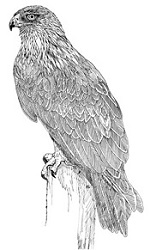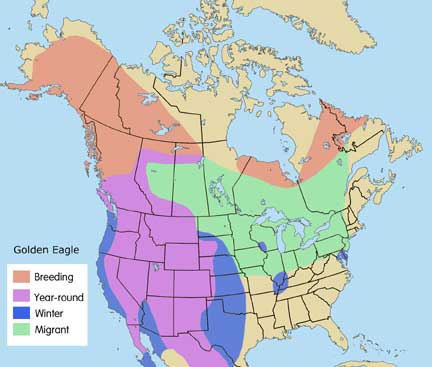
Scientific Name: Aquila chrysaetos
A very large, dark to medium-brown bird with a golden head and nape. Females are larger than males, though plumage is similar. The entire upper-side of the adult bird is dark brown, underside a slightly paler brown, with a buffy color on the legs, which are feathered to the yellow feet. Irregular, indistinct dark gray bands on tail. Head is relatively small than that of a Bald Eagle; the eyes are hazel to dark brown; the beak is dark. It takes four years and several molts for these birds to reach maturity. Juvenile birds have broader wings and longer tails than adults as well as plumage differences, including patterns of whitish areas on the feather, and a tail pattern of a distinctive broad white band and terminal black band. In flight, the wing beats are strong, slow, shallow, and smooth. Gold Eagles soar in a slight dihedral glide with wingtips up, and can dive on prey at speeds up to 200 mph.
Males/Females
Length: 27 – 33″
Wingspan: 72 – 87″
Weight: 6.6 – 14lbs
State and federally protected both under the Migratory Bird Treaty Act (as are all native birds), and the Bald and Golden Eagle Act.
Open mountainous regions of the west, including high deserts, range lands, cayon lands, tundra, alpine areas, open woodlands, to southwestern deserts. Often distant from water, and from low elevations up to 8,000 feet. Uses open areas in any season for hunting; in breeding season needs suitable cliffs, bluffs, rocky outcrops or trees for nesting.
Golden Eagles eat a variety of small to medium-sized mammals up to the size of deer fawn, and also take game birds, snakes, and lizards. Almost all prey is captured on the ground. They will eat carrion, but only rarely attack healthy large mammals. These eagles will take dead or dying lambs, and for this reason are often harassed by ranchers.
Usually quiet, but has a variety of calls: an occasional kya…kya…kya in flight; a weak high series of kee-yep, kee-yep greeting between mates; a strong, screaming kikikiki alarm call.
Enormous stick nests are built on rocky crags, cliffs, and in trees in some areas. Some mated pairs return to the same nest each year, other alternate between several nests. The same nests can be used over many generations of eagles, growing larger each year. If the location allows it, the nest can become really gigantic – as much as eight to ten feet across by three to four feet deep.
Collision with vehicles; electrocution and hitting power lines, especially in the dry habitat these large birds inhabit where tress are scarce and power poles can provide a good hunting perch. Poisonings: lead poisoning from lead shot mammals they might scavenge, rodenticides used to kill prairie dogs or other ground-dwelling mammals whose burrows are deemed a hazard to livestock, and poisoned bait for control of coyotes.

Found throughout the Northern Hemisphere in open mountainous areas. In North America, ranges from Alaska and Canada south throughout the western US, down into central Mexico. Migratory over the coldest northern parts of its range.
Special thanks for range maps:
Dan Gleason
BGleason Design & Illustration
Commercial & Scientific Illustration, Graphic Design
CraneDance Communications
Book Production/Design

